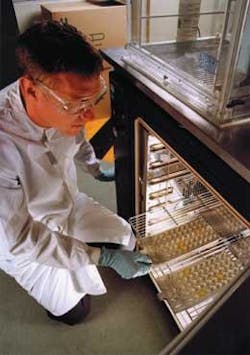Sludge testing labs adopt rapid method for E. coli
By Alex Miller
Many laboratories throughout the UK are switching their E. coli sludge testing procedures from traditional "most probable number" (MPN) methods to the IDEXX rapid microbiological test, Colilert®-18/Quanti-Tray®/ 2000.
The principal reasons for the switch are reduced sample handling time, the ability to provide completed results in 18 hours compared to a possible three to four days, and the method's recent inclusion in the UK Drinking Water Inspectorate's "The Microbiology of Sewage Sludge (2003) - Part 3 -Methods for the isolation and enumeration of Escherichia coli."
Contract laboratory ALcontrol and UK water company South West Water, based in Exeter, UK, are two of the laboratories that recently adopted the new method.
The leading analytical services organisation, ALcontrol, currently carries out up to 100 sludge tests per week at its laboratory in Rotherham, UK, on behalf of regional water company, Yorkshire Water Services. ALcontrol previously employed a MPN test, which used a multiple-tube fermentation process, involving various stages of dilution, pipetting and as many as 15 separate test tubes per sample. The company switched to Colilert-18/Quanti-Tray 2000 because it involves less effort and gives completed results in 18 hours.
Using this method, ALcontrol takes a suitable aliquot of the sludge sample, which is then diluted to 100 ml with RO water and homogenised. Colilert-18 reagent is then added to the sample and dissolved before being poured into the Quanti-Tray/2000, a multi-welled, disposable vessel that holds a 100-ml sample.
The mixture is automatically distributed and sealed into 97 wells by the Quanti-Tray Sealer in less than 20 seconds. The sealed tray is then incubated for 18 hours and the coloured wells are counted. A table converts the number of yellow wells to a coliform count and yellow/fluorescent wells to an E. coli count. Quanti-Tray/2000 eliminates subjective colony interpretation and confirmation. In most instances, ALcontrol reports the results using electronic data transfer, giving E. coli counts for 1g of both wet and dry samples.
South West Water conducts 4000 E. coli sludge tests per annum on both wet and dry samples. The Exeter laboratory, which employs 20 microbiologists, regularly samples 24 sites in rotation over a fortnightly period, with 5 pots of sludge taken from each site.
As with ALcontrol, South West Water previously used a MPN test but decided to conduct a validation study of the Colilert-18/Quanti-Tray method for submission to United Kingdom Accreditation Service. Samples were run in triplicate for digested, limed, pressed and thermally dried and composted sludge. The Colilert-18/Quanti-Tray method compared well with traditional methods for sludge analysis, according to test data compiled by South West Water and ALcontrol.
Author's NoteAlex Miller is the worldwide product manager of Idexx, based in Westbrook, Maine, USA.The Colilert-18 test is based on Defined Substrate Technology®, which is a patented method of detecting bacteria through the effect of their constitutive enzymes on chromogenically and fluorogenically labelled, specific substrates. Colilert-18 detects coliforms and E. coli through the activity of the enzymes beta-D-galactosidase and beta-D-glucuronidase respectively, which are generally accepted as being primary characteristics of these organisms. Colilert-18 contains a specific substrate for each of these enzymes.Quanti-Tray 2000 is a multi-welled, disposable vessel that holds a 100-ml sample, mixed with Colilert-18 reagent. The mixture is automatically distributed and sealed into 97 wells by a Quanti-Tray® Sealer in less than 20 seconds. The sealed tray is then incubated for 18 hours and the coloured wells are counted. A table converts the number of yellow wells to a coliform count and yellow/fluorescent wells to an E. coli count. Quanti-Tray 2000 has a counting range of <1 to >2419 cfu/100 ml

